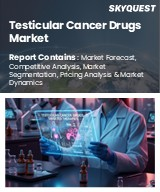
|
시장보고서
상품코드
1622084
암 치료제 시장 : 암 유형, 요법, 최종사용자, 지역별(2024-2031년)Cancer Therapeutics Market By Cancer Type, Therapy, End Users, & Region for 2024-2031 |
||||||
암 치료제 시장 평가, 2024-2031년
암 치료제 시장은 중요한 이정표를 세우며 2023년에는 1,499억 2,000만 달러에 달했습니다. 연구개발 활성화, 제약 기업 간의 협력 강화, 의료 부문의 투자 확대 등 다양한 요인이 이러한 성과에 박차를 가했습니다. 이 시장은 2024-2031년 예측 기간 중 14.6%의 연평균 복합 성장률(CAGR)을 나타낼 것으로 예상되며, 2031년까지 4,914억 1,000만 달러에 달할 것으로 예상되며, 이는 업계의 지속적인 모멘텀과 진화하는 역동성을 반영하고 있습니다. 반영하고 있습니다.
이러한 성장을 지원하는 요인으로는 전 세계 암 발병률 증가, 조기 발견을 촉진하는 정부의 구상, 암 연구의 꾸준한 증가, 기술 발전 등이 있으며, 이 모든 것이 암 치료제의 발전에 기여하고 있습니다.
암 치료제 시장 정의/개요
암 치료제에는 방사선 치료, 화학요법, 수술 등 암세포의 변화를 표적으로 삼아 종양의 성장을 억제하는 치료법이 포함됩니다. 이러한 치료법의 적용은 암의 유형과 병기에 따라 다르며, 면역 요법, 표적 요법, 호르몬 요법, 줄기세포 이식 등의 치료법을 모색하는 연구 및 임상시험이 진행 중입니다. 시장 세분화는 암 유형과 최종사용자에 따라 이루어지며, 특히 아시아, 유럽, 북미 및 남미에서 2031년까지 두 배로 증가할 것으로 예상되는 전 세계 암 발병률 증가가 시장을 주도하고 있습니다.
시장 성장은 제약사들 간의 협력과 연구 노력 증가로 더욱 촉진될 것입니다. 시장 확대의 원동력은 암 인식 제고에 대한 정부의 구상과 맞춤형 의료에 대한 수요입니다.
암 치료제 시장의 성장을 가속하는 요인은 무엇인가?
효과적인 치료 옵션에 대한 수요는 특히 아시아, 유럽, 북미 및 남미 등의 지역에서 전 세계 암 유병률 증가로 인해 촉진되고 있습니다. 이러한 암 환자 증가로 인해 첨단 치료제가 필요하게 되었고, 이는 시장 확대로 이어지고 있습니다. 암 치료제의 혁신은 종양학 분야의 활발한 연구개발이 크게 기여하고 있습니다. 연구와 임상시험을 통한 끊임없는 탐구는 새로운 약물과 치료법의 발견을 촉진하고, 이를 통해 시장은 보다 효과적인 솔루션으로 가득 차게 됩니다.
또한 혁신과 암 치료제 개발의 가속화는 제약회사, 연구기관 및 다양한 이해관계자들의 협력을 통해 촉진될 수 있습니다. 이러한 파트너십은 자원 풀과 지식 공유를 촉진하여 더 강력한 파이프라인과 신약의 신속한 시장 출시를 가능하게 합니다. 또한 암에 대한 인식을 높이고 조기 발견을 촉진하며 연구 자금을 제공하기 위한 정부의 구상도 시장 성장을 가속하고 있습니다.
암 환자가 이용할 수 있는 치료 옵션의 확대는 게놈 검사의 발전과 기술 혁신에 힘입어 환자 개개인프로파일에 맞는 맞춤형 의료에 대한 수요가 증가하고 있는 데에 기인합니다. 이러한 요인들이 복합적으로 작용하여 암 치료제 시장의 지속적인 발전과 확대에 유리한 환경을 조성하고 있습니다.
암 치료제 시장 매출 급락의 원인은?
블록버스터 의약품의 특허 만료로 인한 제네릭 의약품의 등장은 경쟁을 심화시키고 브랜드 암 치료제의 가격을 낮춥니다. 이러한 경쟁의 심화는 제약회사에 도전이 되고, 기업 매출의 감소로 이어집니다. 또한 새로운 암 치료제에 대한 접근성은 의약품 승인 및 상환에 대한 엄격한 규제 요건과 의료보험 지불자의 가격 압력으로 인해 제한되고 있습니다. 규제 당국의 승인 지연과 상환 정책 변경은 암 치료제의 채택을 더욱 제한하고 매출에 부정적인 영향을 미칩니다.
특히 특허 보호가 만료된 약품의 경우, 브랜드 암 치료제의 제네릭 의약품 도입은 오리지널 기업의 가격 하락과 매출 감소에 큰 영향을 미치고 있습니다. 치료 패러다임은 암 연구의 발전과 면역 요법, 분자 표적 치료와 같은 새로운 치료법에 대한 의료 서비스 프로바이더의 선호도 변화에도 영향을 받습니다. 이러한 변화는 전통적인 화학요법의 사용을 감소시켜 전통적인 암 치료제의 매출에 더 많은 영향을 미칠 수 있습니다. 경기 침체, 의료비 지출의 변화, 상환 변동과 같은 경제적 요인과 치료 순응도 및 접근성 문제는 이러한 경쟁 환경 속에서 제약사가 매출 성장을 유지하는 데 있으며, 직면한 과제를 더욱 복잡하게 만들고 있습니다.
목차
제1장 세계의 암 치료제 시장, 서론
- 시장 개요
- 조사 범위
- 전제조건
제2장 개요
제3장 VERIFIED MARKET RESEARCH의 조사 방법
- 데이터 마이닝
- 밸리데이션
- 일차 인터뷰
- 데이터 소스 리스트
제4장 세계의 암 치료제 시장 전망
- 개요
- 시장 역학
- 촉진요인
- 억제요인
- 기회
- Porter's Five Forces 모델
- 밸류체인 분석
제5장 세계의 암 치료제 시장, 암 유형별
- 개요
- 혈액암
- 폐암
- 유방암
- 소화기암
- 대장암
- 부인과 암
- 전립선암
- 기타
제6장 세계의 암 치료제 시장, 요법별
- 개요
- 화학요법
- 표적치료
- 면역치료
- 호르몬 요법
- 기타
제7장 세계의 암 치료제 시장, 최종사용자별
- 개요
- 병원
- 전문 클리닉
- 암·방사선 치료 센터
제8장 세계의 암 치료제 시장, 지역별
- 개요
- 북미
- 미국
- 캐나다
- 멕시코
- 유럽
- 독일
- 영국
- 프랑스
- 기타 유럽
- 아시아태평양
- 중국
- 일본
- 인도
- 기타 아시아태평양
- 세계의 기타 지역
- 라틴아메리카
- 중동 및 아프리카
제9장 세계의 암 치료제 시장, 경쟁 구도
- 개요
- 각사 시장 순위
- 주요 개발 전략
제10장 기업 개요
- F. Hoffmann-La Roche AG
- Bristol-Myers Squibb Company
- AbbVie, Inc.
- Johnson & Johnson
- Celgene Corporation
- Astellas Pharma Inc.
- Pfizer, Inc.
- Novartis AG
- Merck KGaA
- Bayer AG
제11장 부록
- 관련 조사
Cancer Therapeutics Market Valuation - 2024-2031
Significant milestones were achieved in the Cancer Therapeutics Market, with a value of USD 149.92 Billion attained in 2023. Various factors, including heightened research and development endeavors, greater collaboration among pharmaceutical entities, and amplified investments within the healthcare sector, fueled this achievement. The market is anticipated to witness a promising trajectory, with a projected CAGR of 14.6% during the forecast period from 2024 to 2031. By 2031, it is expected to soar to an impressive value of USD 491.41 Billion, reflecting the sustained momentum and evolving dynamics within the industry.
This growth is underpinned by factors such as the escalating prevalence of cancer globally, governmental initiatives promoting early detection, and the steady rise in cancer research endeavors, coupled with technological advancements, all contributing to the advancement of cancer therapeutics.
Cancer Therapeutics Market: Definition/Overview
Cancer therapeutics encompass treatments aimed at targeting alterations in cancer cells to impede tumor growth, including radiotherapy, chemotherapy, and surgery. The application of these therapies varies based on cancer type and stage, with ongoing research and clinical trials exploring treatments such as immunotherapy, targeted therapy, hormone therapy, and stem cell transplant. Market segmentation, based on cancer type and end users, is driven by the global rise in cancer prevalence, expected to double by 2031, particularly in Asia, Europe, and the Americas.
Market growth is further propelled by collaboration between pharmaceutical companies and increased research efforts. Market expansion is driven by government initiatives for cancer awareness and the demand for personalized medicine.
What's inside a VMR industry report?
Our reports include actionable data and forward-looking analysis that help you craft pitches, create business plans, build presentations and write proposals.
What Factors are Driving the Growth of the Cancer Therapeutics Market?
The demand for effective treatment options is propelled by the escalating prevalence of cancer globally, particularly in regions such as Asia, Europe, and the Americas. This rise in cancer cases necessitates advanced therapeutics, leading to market expansion. Innovation in cancer therapeutics is significantly contributed by heightened research and development endeavors within the field of oncology. Continuous exploration through studies and clinical trials facilitates the discovery of novel drugs and treatment modalities, thereby enriching the market with more effective solutions.
Moreover, innovation and the acceleration of cancer therapeutics development are fostered by collaborative efforts among pharmaceutical companies, research institutions, and various stakeholders. These partnerships facilitate resource pooling and knowledge sharing, resulting in more robust pipelines and the quicker introduction of new drugs to the market. Furthermore, market growth is bolstered by government initiatives aimed at raising cancer awareness, promoting early detection, and providing funding for research.
The expansion of treatment options available to cancer patients is driven by the growing demand for personalized medicine tailored to individual patient profiles, fueled by advances in genomic testing and technological innovations. This convergence of factors creates a favorable environment for the continuous progression and expansion of the Cancer Therapeutics Market.
What Factors are Plummeting Sales of Cancer Therapeutics Market?
The availability of generic versions due to patent expirations on blockbuster drugs intensifies competition and drives down prices for branded cancer therapeutics. This increased competition poses challenges for pharmaceutical companies, leading to reduced sales revenue. Also, easy accessibility to new cancer therapeutics is restricted by stringent regulatory requirements for drug approval and reimbursement, as well as pricing pressures from healthcare payers. Delays in regulatory approvals or changes in reimbursement policies further limit the adoption of cancer therapeutics, resulting in negative impact on sales.
The introduction of generic versions of branded cancer therapeutics, particularly for drugs losing patent protection, contributes to significant price erosion and decreased sales for originator companies. Treatment paradigms are also influenced by advances in cancer research, and shifting preferences of healthcare providers towards emerging therapies such as immunotherapy and targeted treatments. This shift may reduce the utilization of traditional chemotherapy, further impacting sales of conventional cancer therapeutics. Economic factors, including downturns, changes in healthcare spending, and fluctuations in reimbursement, as well as challenges related to treatment adherence and access issues, further compound the challenges faced by pharmaceutical companies in maintaining revenue growth in this competitive landscape.
Category-Wise Acumens
Which Therapy Type Category Holds the Dominant Market Share in the Cancer Therapeutics Market?
In the forecasted period, the targeted therapy segment is expected to demonstrate the highest Compound Annual Growth Rate (CAGR), attributed to its specificity toward cancer cells while minimizing toxicity to off-target cells. This category encompasses various therapeutic approaches, such as hormone therapies, gene expression modulators, apoptosis inducers, angiogenesis inhibitors, immunotherapies, signal transduction inhibitors, and toxin delivery molecules.
With cancer cells precisely targeted and healthy cells spared from harm, targeted therapy presents a promising avenue for more effective and tolerable cancer treatment options. Consequently, it contributes significantly to its dominance in the Cancer Therapeutics Market.
Will the Emergence of Cancer and Radiation Therapy Centres Drive Growth in the Cancer Therapeutics Market?
The growth of the Cancer Therapeutics Market is expected to be driven by the emergence of Cancer and Radiation Therapy Centres. It is anticipated that the largest market share will be held by the Cancer & Radiation Therapy Centre due to several factors. These centers are regarded as pivotal in the administration of cancer therapeutics, serving as hubs for a significant number of cancer treatments. Patients are often provided with a variety of treatments, including chemotherapy, radiotherapy, and targeted therapy, all of which contribute to the demand for cancer therapeutics.
Additionally, specialized equipment and expertise required for advanced treatment modalities are often housed within these centers, further driving the need for therapeutic interventions. Therefore, as Cancer and Radiation Therapy Centres continue to expand and cater to the increasing number of cancer patients, they are poised to play a central role in fueling the growth of the Cancer Therapeutics Market.
Could North America Drive an Increase in the Sales within the Cancer Therapeutics Market?
An increase in sales within the Cancer Therapeutics Market could be driven by North America. The region is positioned to dominate the market, primarily due to the widespread adoption of cancer therapeutics and significant funding provided by various organizations operating within the region. With advanced cancer treatment options being widely adopted and substantial financial support being provided by both public and private sectors in North America, the region is poised to stimulate growth in sales within the Cancer Therapeutics Market.
Furthermore, North America's leadership in the adoption of advanced cancer treatment options and its robust financial support from both public and private sectors contribute to its advantageous position. This favorable environment fosters a conducive landscape for the expansion of cancer therapeutics sales, positioning North America as a key driver of market growth.
Will the Sales of Cancer Therapeutics Market fare well in Asia Pacific?
The sales of the Cancer Therapeutics Market are expected to perform well in the Asia Pacific region. With high prevalence of cancer and increasing awareness about the importance of early detection and treatment, there is a significant growth in demand for cancer therapeutics in Asia Pacific. The region's potential for robust sales of cancer therapeutics is further enhanced by advancements in healthcare infrastructure and increasing investments in research and development activities. A surge in collaborations between pharmaceutical companies and healthcare institutions is being witnessed in this region, fostering innovation and the introduction of novel cancer treatment options, driving market growth.
The Government initiatives aimed at improving cancer care and access to treatment, along with the growing adoption of personalized medicine approaches, are expected to bolster the sales of cancer therapeutics in Asia Pacific. As healthcare systems in countries across the Asia Pacific continue to evolve and improve, there is a growing focus on addressing the unmet medical needs of cancer patients, presenting significant opportunities for market expansion in the region.
Competitive Landscape
Examining the competitive landscape of the Cancer Therapeutics Market is considered crucial for gaining insights into the industry's dynamics. This research aims to analyze the competitive landscape, focusing on key players, market trends, innovations, and strategies. By conducting this analysis, valuable insights will be provided to industry stakeholders, assisting them in effectively navigating the competitive environment and seizing emerging opportunities. Understanding the competitive landscape will enable stakeholders to make informed decisions, adapt to market trends, and develop strategies to enhance their market position and competitiveness in the Cancer Therapeutics Market.
Some of the prominent players operating in the Cancer Therapeutics Market include:
Hoffmann-La Roche AG, Bristol-Myers Squibb Company, AbbVie, Inc., Johnson & Johnson, Celgene Corporation, Astellas Pharma Inc., Pfizer Inc., Novartis AG, Merck KGaA, Bayer AG, and Takeda Pharmaceutical Company Limited.
Latest Developments
In February 2024, Bristol-Myers Squibb attained FDA approval for OPDIVO (nivolumab) alongside Yervoy (ipilimumab) for the initial treatment of patients diagnosed with locally advanced or metastatic urothelial carcinoma (bladder cancer).
In February 2024, Merck & Co. revealed encouraging outcomes from a Phase 3 clinical trial of Keytruda (pembrolizumab) combined with chemotherapy as the primary therapy for advanced non-small cell lung cancer (NSCLC). The study exhibited a statistically significant enhancement in overall survival in comparison to chemotherapy alone.
In January 2024, Johnson & Johnson's Janssen unit disclosed favorable findings from a Phase 3 trial of Darzalex (daratumumab) combined with bortezomib and lenalidomide for managing patients with newly diagnosed multiple myeloma. The study highlighted a statistically significant advancement in progression-free survival when contrasted with the administration of lenalidomide and bortezomib alone.
TABLE OF CONTENTS
1. INTRODUCTION OF GLOBAL CANCER THERAPEUTICS MARKET
- 1.1. Overview of the Market
- 1.2. Scope of Report
- 1.3. Assumptions
2. EXECUTIVE SUMMARY
3. RESEARCH METHODOLOGY OF VERIFIED MARKET RESEARCH
- 3.1. Data Mining
- 3.2. Validation
- 3.3. Primary Interviews
- 3.4. List of Data Sources
4. GLOBAL CANCER THERAPEUTICS MARKET OUTLOOK
- 4.1. Overview
- 4.2. Market Dynamics
- 4.2.1. Drivers
- 4.2.2. Restraints
- 4.2.3. Opportunities
- 4.3. Porters Five Force Model
- 4.4. Value Chain Analysis
5. GLOBAL CANCER THERAPEUTICS MARKET, BY CANCER TYPE
- 5.1. Overview
- 5.2. Blood Cancer
- 5.3. Lung Cancer
- 5.4. Breast Cancer
- 5.5. Gastrointestinal Cancer
- 5.6. Colorectal Cancer
- 5.7. Gynecologic Cancer
- 5.8. Prostate Cancer
- 5.9. Others
6. GLOBAL CANCER THERAPEUTICS MARKET, BY THERAPY
- 6.1. Overview
- 6.2. Chemotherapy
- 6.3. Targeted Therapy
- 6.4. Immunotherapy
- 6.5. Hormonal Therapy
- 6.6. Others
7. GLOBAL CANCER THERAPEUTICS MARKET, BY END USERS
- 7.1. Overview
- 7.2. Hospitals
- 7.3. Specialty Clinics
- 7.4. Cancer and Radiation Therapy Centres
8. GLOBAL CANCER THERAPEUTICS MARKET, BY GEOGRAPHY
- 8.1. Overview
- 8.2. North America
- 8.2.1. U.S.
- 8.2.2. Canada
- 8.2.3. Mexico
- 8.3. Europe
- 8.3.1. Germany
- 8.3.2. U.K.
- 8.3.3. France
- 8.3.4. Rest of Europe
- 8.4. Asia Pacific
- 8.4.1. China
- 8.4.2. Japan
- 8.4.3. India
- 8.4.4. Rest of Asia Pacific
- 8.5. Rest of the World
- 8.5.1. Latin America
- 8.5.2. Middle East & Africa
9. GLOBAL CANCER THERAPEUTICS MARKET COMPETITIVE LANDSCAPE
- 9.1. Overview
- 9.2. Company Market Ranking
- 9.3. Key Development Strategies
10. COMPANY PROFILES
- 10.1. F. Hoffmann-La Roche AG
- 10.1.1. Overview
- 10.1.2. Financial Performance
- 10.1.3. Product Outlook
- 10.1.4. Key Developments
- 10.2. Bristol-Myers Squibb Company
- 10.2.1. Overview
- 10.2.2. Financial Performance
- 10.2.3. Product Outlook
- 10.2.4. Key Developments
- 10.3. AbbVie, Inc.
- 10.3.1. Overview
- 10.3.2. Financial Performance
- 10.3.3. Product Outlook
- 10.3.4. Key Developments
- 10.4. Johnson & Johnson
- 10.4.1. Overview
- 10.4.2. Financial Performance
- 10.4.3. Product Outlook
- 10.4.4. Key Developments
- 10.5. Celgene Corporation
- 10.5.1. Overview
- 10.5.2. Financial Performance
- 10.5.3. Product Outlook
- 10.5.4. Key Developments
- 10.6. Astellas Pharma Inc.
- 10.6.1. Overview
- 10.6.2. Financial Performance
- 10.6.3. Product Outlook
- 10.6.4. Key Developments
- 10.7. Pfizer, Inc.
- 10.7.1. Overview
- 10.7.2. Financial Performance
- 10.7.3. Product Outlook
- 10.7.4. Key Developments
- 10.8. Novartis AG
- 10.8.1. Overview
- 10.8.2. Financial Performance
- 10.8.3. Product Outlook
- 10.8.4. Key Developments
- 10.9. Merck KGaA
- 10.9.1. Overview
- 10.9.2. Financial Performance
- 10.9.3. Product Outlook
- 10.9.4. Key Developments
- 10.10. Bayer AG
- 10.10.1. Overview
- 10.10.2. Financial Performance
- 10.10.3. Product Outlook
- 10.10.4. Key Developments
11. Appendix
- 11.1. Related Research



















